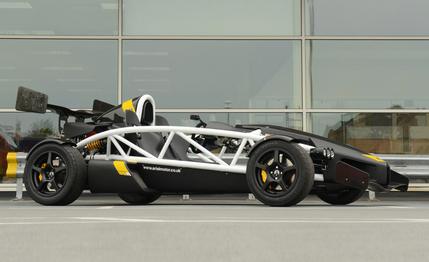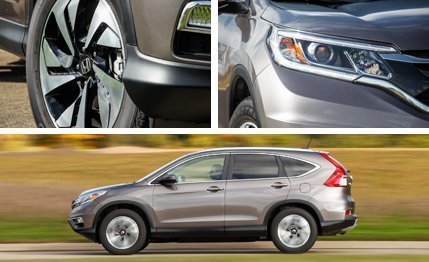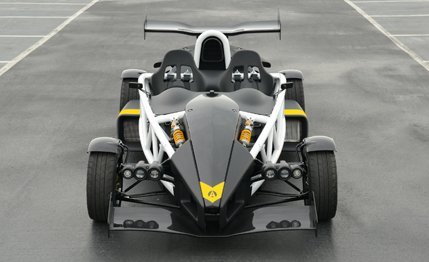
 First Drive Review
First Drive Review
Given the free choice of locations, where would you drive a 350-hp Ariel Atom? A flowing Alpine pass in the summer sunshine? Or a nice, quiet racetrack surrounded by deep run-off areas? Maybe you’d just nominate a nice wide runway to safely explore the performance of a car with a power-to-weight ratio not far removed from that of an early Can-Am racer.
I have the narrow, twisty roads that surround Ariel’s factory in Somerset, England. And—as it tends to in wintertime around these parts—it’s raining.
So let’s start with the scary numbers. Even by the mad standards of Atom power-to-weight ratios, the 3.5R stands out as something special. Power comes from a supercharged Honda 2.0-liter four-cylinder, the biggest point of difference from the Ariel we can get in the U.S., which has a 2.4-liter engine with an optional turbocharger. This drives the rear wheels via—in the case of the car we’re testing—an optional six-speed Sadev sequential transmission.
In the Atom pantheon, the 3.5R sits very nearly at the top. It has 125 fewer horsepower than a road-tuned limited-edition Atom V-8, and 15 fewer horsepower than the recently announced U.S.-market turbo Atom 3S, but extreme weight saving, even by Ariel’s less-than-luxurious standards, means it’s lighter and more agile. It weighs just 1210 pounds dry, and even with the extra mass of a driver and half a tank of fuel onboard, it still has only about 4 pounds for every horsepower. Ariel claims that, on tight and/or twisty racetracks, this is the fastest street-legal Atom so far.


A preliminary inspection of the car I’ll be driving also shows it’s sitting on track-biased Kumho Ecsta V700 tires, with the sort of minimal groove pattern that makes it look as if whoever was cutting them left the job half finished.
And it’s raining. Did I mention that?
Getting in is easy enough. The Atom’s lack of bodywork liberates you from the usual contortions necessary to gain egress to a track special. With no doors or roof, you just climb over the birdcage tub, stand on the plastic driver’s seat, and then slide down behind the steering wheel. There are six-point harnesses and a minimum of distractions, with instrumentation limited to a multifunction display screen behind the steering wheel surrounded by a modest selection of switches and buttons.
The only real surprise is the presence of a clutch pedal in addition to the metal paddles that sit behind the steering wheel. This is necessary as the sequential gearbox accepts only clutchless full-throttle “flat” changes when being used hard.
The engine fires into noisy life, first gear arrives with a clunk, and then—after balancing the abruptly biting clutch on the edge of an embarrassing stall—I head out onto the Queen’s highway.


Against expectations, the 3.5R isn’t instantly terrifying. The supercharger whines loudly and there’s lots of engine noise and vibration through the tub, but the engine is tractable and very well behaved at low revs, and the unassisted steering is direct without being darty. Ride quality is surprisingly good, as there’s not much mass for the springs and fully adjustable dampers to have to deal with. This is good news for anyone planning to use an Atom to create the world’s quickest Uber service.
Even with the clutch depressed, the sequential transmission bangs in changes with a brutal enthusiasm. But the Atom is easy to place despite the narrowness of these roads, and visibility is predictably excellent. You can keep a close eye on the front suspension as it moves through the gaps in the tubing; this is dangerously mesmerizing. Passing through the local town, Crewkerne, also gives an excellent demonstration of English manners. At a red stoplight, a pedestrian stops and holds his umbrella over the cockpit to help keep the rain off.
Out of town, things get much more interesting. And at least initially, slightly more scary. It’s an introduction to the biggest wet-weather limiting factor of an Atom 3.5R shod on what are basically cut slicks: wheelspin. With third gear engaged, the throttle is less than halfway to its stop before the engine overwhelms the available grip and the revs soar, the sequential gearbox’s upshift lights blazing into life all at once. Shifting into fourth calms everything down, but the same thing happens as the engine climbs toward the 6100-rpm point at which it delivers peak torque. The Atom certainly feels fast, especially given the close proximity of some of Somerset’s sharp-edged dry-stone walls, but it’s frustrating not to be able to experience how ludicrously beyond fast it should be.


Yet the car isn’t short of lateral grip, which is shocking given the pseudo slicks. As with all Atoms, the steering has a decent amount of feedback and a strong caster feel, self-centering with a forceful keenness as you exit corners. Experience quickly demonstrates that you can lean far harder on the 3.5R than was possible in some earlier, snappier Atoms, with the dependable front end edging into mild understeer well before the rear tires give up. And, of course, you’re still free to try to dictate the back end’s attitude with the throttle if you’re brave enough. You’d need to be hearing the clanking of brass on brass from inside your pants to consider any outright drifting on these roads, in these conditions. But the Atom can be felt to tighten its line nicely as the torque reaches the rear end.
Eventually—just as moisture is wicking its way to the top of my legs—the rain eases, then stops. And, by the simple expedient of spotting a blue patch of sky and then aiming for it, the Atom and I find ourselves on some almost-dry blacktop. The roads are still narrow, the stone walls close, but there are some chances to put the gas pedal to the floor. It’s like that moment when Han Solo punches the hyperdrive, only with sheep and fields and quaint English tearooms instead of stars, but it’s all accompanied by the appropriately space-age wail of the supercharger.
There’s no fear at all, a stark contrast to what this power-to-weight ratio would feel like applied to a car with two or three times the mass. There’s no scrambling or scrabbling for grip; it hooks up and just goes. Getting the chance to experience the transmission making clutchless, flat-out changes between ratios is almost as impressive; you know there must be a gap in there, but it’s all but undetectable. It’s a level of acceleration that even a Le Mans veteran or a fighter-jet pilot would never grow bored of.
But then it starts to rain again, and I’m out of blue sky to head toward. By the time the Atom and I get back to the factory, I’m well beyond wet and into sodden, squelching as I walk away from the car. It’s been fun, in a masochistic way, but next time I’m definitely going to bring rubber trousers.